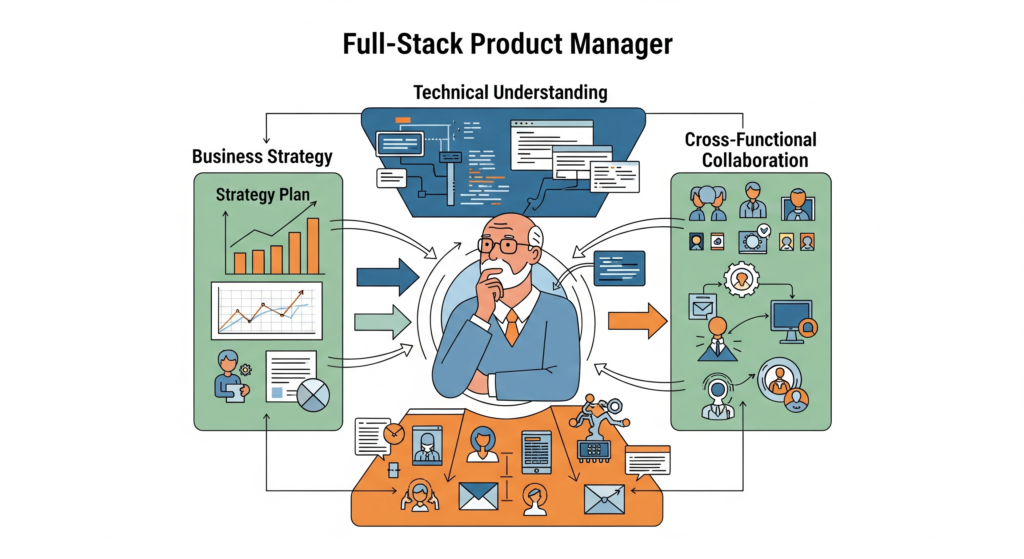The traditional PM, focused heavily on user stories and sprint backlogs, is no longer sufficient. Today’s market demands product leaders who can seamlessly bridge the gap between technical execution and overarching business objectives, ensuring every product decision contributes directly to the company’s bottom line.
Pillar 1: Strategic Acumen & Business Leadership
A true full-stack PM doesn’t just build products; they build businesses through products. This requires a profound shift in mindset from simply managing outputs to driving tangible outcomes.
From Output to Outcome: Measuring What Matters
Gone are the days when a product’s success was solely measured by shipped features. The modern PM is accountable for quantifiable business results: increased revenue, improved market share, higher customer lifetime value (LTV), or reduced churn. This means diving deep into analytics, setting clear Key Performance Indicators (KPIs) linked to business goals, and constantly optimizing the product to move those needles.
The Commercial PM: Understanding the Revenue Levers
A full-stack PM is intimately familiar with the commercial aspects of their product. This includes understanding pricing strategies, navigating go-to-market (GTM) motions, collaborating effectively with sales and marketing teams for sales enablement, and grasping the intricacies of customer success. It’s about recognizing how the product fits into the broader commercial ecosystem and actively contributing to its profitability.
Financial Literacy for Product Decisions
You don’t need to be a CFO, but a basic grasp of financial statements, ROI calculations, and budgeting is crucial. How does a particular feature impact the product’s profit and loss (P&L)? What’s the cost of delay for a critical release? Understanding these financial implications allows PMs to make data-backed, economically sound decisions that align with organizational priorities.
Pillar 2: Technical Fluency & Architectural Awareness
While a full-stack PM isn’t expected to write production code, a deep appreciation for the technical landscape is non-negotiable. This isn’t about becoming an engineer, but rather becoming a more effective partner to them.
Beyond User Stories: Grasping the Tech Stack
A full-stack PM understands the underlying architecture of their product. This includes familiarity with APIs, database structures, scalability considerations, and cloud infrastructure. This knowledge enables more informed conversations with engineering teams, leading to realistic roadmaps, better technical specifications, and foresight into potential system limitations or opportunities.
Bridging the Gap: Speaking the Engineering Language
Technical fluency fosters stronger collaboration. When PMs can articulate requirements in a way that resonates with engineers, and understand the technical challenges and trade-offs involved, communication becomes more efficient. This mutual understanding accelerates development cycles and reduces costly misunderstandings.
Understanding Technical Debt & Strategic Investment
A full-stack PM recognizes the long-term implications of technical debt and advocates for its strategic management. They understand that investing in the product’s technical foundation, even if it doesn’t immediately deliver new user-facing features, is crucial for long-term maintainability, performance, and future innovation.
Pillar 3: Cross-Functional Orchestration & Ecosystem Navigation
The full-stack PM is the ultimate connector, ensuring all parts of the organization are aligned and moving towards a unified product vision.
The Ultimate Integrator: Unifying the Organization
Product managers sit at the intersection of virtually every department: engineering, design, marketing, sales, customer support, and even legal. The full-stack PM excels at being the integrator, translating insights and requirements between these diverse groups and ensuring everyone is pulling in the same direction.
Stakeholder Harmony: Managing Expectations and Building Consensus
With so many stakeholders involved, managing expectations and fostering consensus is an art. The full-stack PM employs strong communication, negotiation, and influencing skills to align diverse perspectives, resolve conflicts, and gain buy-in for product initiatives. This often involves data-driven diplomacy and a clear articulation of strategic rationale.
External Ecosystems: Product in a Broader Context
Modern products rarely exist in isolation. A full-stack PM considers the broader external ecosystem: strategic partnerships, integrations with other platforms, and how the product fits into the overall industry landscape. This holistic view helps identify new opportunities and potential threats.
Cultivating Your Full-Stack Capabilities
Becoming a full-stack PM is a journey of continuous learning and deliberate practice.
- Strategic Skill Development: Actively seek opportunities to enhance your skills in data analytics, financial modeling, market research, and GTM strategy. Online courses, industry certifications, and business books can be valuable resources.
- Learning Beyond Product: Don’t just stay in your product silo. Spend time with your sales team on calls, shadow customer support representatives, attend marketing strategy sessions, and even participate in engineering discussions beyond your direct scope. The more you understand other functions, the more effective you’ll be.
- Mentorship & Continuous Learning: Find experienced leaders who embody the full-stack mindset and seek their guidance. Engage in industry communities, attend conferences, and stay abreast of the latest technological and business trends.
The Strategic Imperative
The rise of the full-stack Product Manager is more than just a trend; it’s a fundamental shift in how organizations build and deliver value. By embracing a broader skill set encompassing strategic acumen, technical fluency, and cross-functional orchestration, PMs can transform from mere feature custodians into true business leaders. This evolution not only propels individual careers but also builds more resilient, innovative, and ultimately successful products and organizations.
The future of product leadership belongs to those who can see the entire strategic chessboard, not just their own pieces. Are you ready to become a full-stack force?

